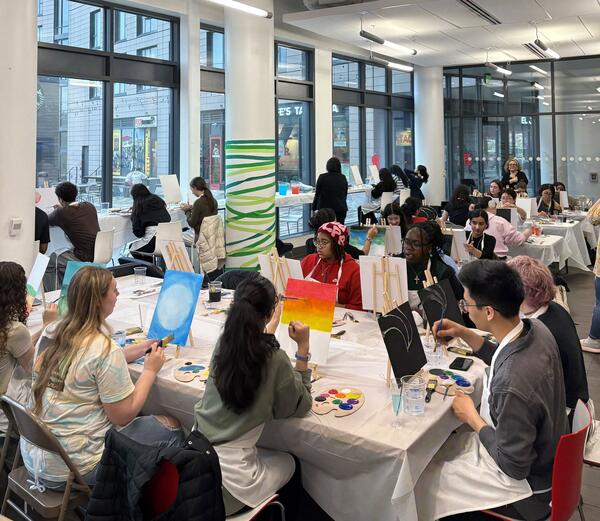After yet another rocky year for higher education, student success administrators retain high confidence in their institution’s core mission: Some 95 percent rate the quality of undergraduate education delivered as good or excellent, according to Inside Higher Ed’s second annual Survey of College and University Student Success Administrators with Hanover Research.
About the Survey
On Wednesday, Dec. 10, at 2 p.m. Eastern, Inside Higher Ed will present a free webcast to discuss the results of the 2025 Survey of College and University Student Success Administrators. Please register here—and plan on bringing your questions about student success going into 2026.
This survey was conducted Aug. 20–Oct. 6 with Hanover Research. Respondents number 204 student success leaders, most of whom work in student affairs at the executive level at public and private nonprofit institutions. The survey’s margin of error is plus or minus seven percentage points. A copy of the free report can be downloaded here.
This independent editorial survey was made possible by support from the Gates Foundation and Studiosity.
Most student success administrators (85 percent) also report strong feelings of connection to students served, and nearly as many say they’re satisfied in their roles. Yet leaders continue to worry about the forces holding students back. Selecting up to three options from a longer list, administrators cite mental health challenges (51 percent describe this as a top challenge), financial constraints (49 percent) and lack of adequate preparation before college (48 percent) as the top barriers to student success at their institution. Community college leaders are disproportionately concerned about students needing to work while enrolled (67 percent).
Just about half of all administrators believe their institution is highly responsive to student needs for flexibility, such as in times of personal or academic crises.
A larger share of respondents, 61 percent, believe their institution is highly effective in prioritizing student success. Just 35 percent say it’s highly effective in using student success data to drive decisions, however. Both of these figures are similar to last year’s survey, meaning the gap between aspiration and data-driven change remains.
Student affairs leaders who responded to NASPA’s own annual Top Issues in Student Affairs survey this year flagged “using dashboards and other data communication tools to help senior administrators translate data into actionable insights for decision-making” as a top issue for institutions, behind only “protecting the institution against cyberattacks” and “navigating political and legislative pressures affecting institutional policies and practices.”
Colleges can certainly do more to harness the extraordinary number of student data points available to them every day. But Amelia Parnell, NASPA’s president, told Inside Higher Ed that she’d give student success leaders “a little more credit” for their use of data—especially the qualitative kind.
“We need both quantitative data to see scale and impact and qualitative data to understand the nuances,” including around learning and engagement, she said. “I think professionals have quite a bit of qualitative context about students’ experiences because they spend a lot of time connecting directly with them.”
Other top areas of concern for student success administrators include affordability, artificial intelligence and policy impacts on campus life, finds Inside Higher Ed’s survey.
Affordability and Value
A third of student success administrators say that their trust in higher education has waned in recent years, and many point to concerns about affordability (64 percent) and long-term value of a degree (62 percent) as top drivers of declining public confidence. Leaders also highlight tighter alignment between academic programs and career pathways as a key lever for rebuilding trust.
About six in 10 respondents are highly confident that their institution is actively working to keep costs affordable, with public institution leaders especially likely to say so (69 percent versus 49 percent of private nonprofit peers).
But just 11 percent of leaders think students at their institution clearly understand the total cost of attendance, beyond tuition. They raise similar concerns about students’ awareness and understanding of emergency funding resources at their institution.
In Inside Higher Ed’s main Student Voice survey this year, just 27 percent of students said they understand the total cost of attendance fully and can budget appropriately. More than three in five didn’t know if their college offers emergency aid. Yet 61 percent of student success administrators say this kind of help is available at their institution.
Some additional context—and evidence of misalignment between student experience and administrator perception: In Inside Higher Ed’s 2025 Survey of College and University Chief Business Officers, most CBOs (88 percent) said that their institution is transparent about the full, net cost of attendance, including tuition discounts and counting fees and other expenses—though just 42 percent said this of colleges and universities as a whole. Most CBOs also said that their institution’s net price is sufficiently affordable.
Parnell of NASPA noted that financial aid “is but one part of the cost of attendance discussion for some students.” But she added that financial aid offers represent an opportunity for colleges to improve clarity and transparency around total cost—something the National Association of Student Financial Aid Administrators and others have urged.
Preparing Students for an AI Future
Just 2 percent of student success leaders say their institution is very effective in helping students understand how, when and whether to use generative artificial intelligence in academic settings. On promoting academic integrity, specifically, 77 percent endorse educating students about ethical AI use rather than emphasizing punitive measures. Faculty and staff development and efforts to standardize use policies also rank high.
In the Student Voice survey, just 13 percent of students said they didn’t know when, how and whether to use generative AI for coursework—but most of the remainder attributed their knowledge to individual faculty efforts rather than broader institutional ones.
Student success administrators also describe a gap between the extent to which high-impact teaching practices, such as those endorsed by the American Association of Colleges and Universities, are highly encouraged at their institution and widely adopted (65 percent versus 36 percent, respectively). And while 87 percent agree that students graduate from their college ready to succeed in today’s job market, half (51 percent) believe their institution should focus more on helping students find paid internships and other experiential learning opportunities.
Tawnya Means, an innovation consultant who recently joined Bowling Green State University and its Schmidthorst College of Business as a strategic innovation and AI adviser, said that all three of these concerns—lack of institutional guidance on AI, high-impact teaching practices and other opportunities for experiential learning and internships—are connected.
“Schools treating AI as a catalyst for pedagogical redesign are simultaneously increasing high-impact practices and preparing students for AI-augmented careers,” she said. And institutions doing this well are using some common strategies: making faculty development about pedagogy, not just “AI compliance,” and designing assignments where AI supports real learning. Unpacking the latter point, Means praised approaches that are experiential, teach discipline-specific or contextual AI use versus abstract rules, and mirror actual workplaces.
While business schools have long understood the power of “messy real-world case studies,” Means said they’re ripe for use across undergraduate education in the generative AI era and “resist simple AI shortcuts.”
Parnell suggested on-campus employment as yet another way to provide “work experience and support students in their learning journey.”
On AI specifically, Asim Ali, executive director of the Biggio Center for the Enhancement of Teaching and Learning at Auburn University, who’s worked with many institutions on faculty development, said the “biggest gap I see is not engaging students in the process.”
At Auburn, he said, student government leaders have taken a “focused interest directly in shaping how we support GenAI learning.” And in discussions between student leaders and faculty, “both groups emphasized that students must also take responsibility for learning the ethics and appropriate use of GenAI.”
The biggest gap I see is not engaging students in the process.”
—Asim Ali, executive director of the Biggio Center for the Enhancement of Teaching and Learning at Auburn University
Financial worries and uncertainty about the future top the list of students’ postcollege stressors, as ranked by student success administrators. And just a quarter of these leaders say their institution makes postgraduate outcomes are easily accessible.
Policy Impacts and Campus Climate
Almost all leaders say students feel welcomed, valued and supported on their campuses, and 87 percent say their institution is doing a good or excellent job promoting a positive campus climate. Yet regional differences emerge: Leaders in the South are somewhat less likely than peers elsewhere to say their institution is highly effective in encouraging diverse perspectives among students.
Nearly two in three leaders (62 percent) say recent federal restrictions on diversity, equity and inclusion initiatives have negatively impacted students, and the rate is higher among public institution leaders than their private nonprofit peers.
In the Student Voice survey, 48 percent of students said such changes had negatively impacted their college experience or that of peers; most of the remainder saw no change, rather than a positive one.
Most administrators also believe new student aid policies, such as those included in the One Big Beautiful Bill Act, will limit access to college rather than expand it. And many already report moderate (39 percent) or significant (29 percent) declines in international student enrollments tied to recent federal actions, such as visa appointment restrictions and targeted actions at specific institutions.
Leaders estimate that 40 percent of students participate in no extracurricular activities, a figure that rises to 67 percent among community college administrators. Respondents are mostly like to say involvement would increase if students saw a clear connection between activities and their career goals.
For institutions struggling to get students in involved, Parnell highlighted the importance of effectively communicating and delivering available activities to students: Are any activities at community colleges, which serve many working students, available after 5 p.m., for example, she asked?











